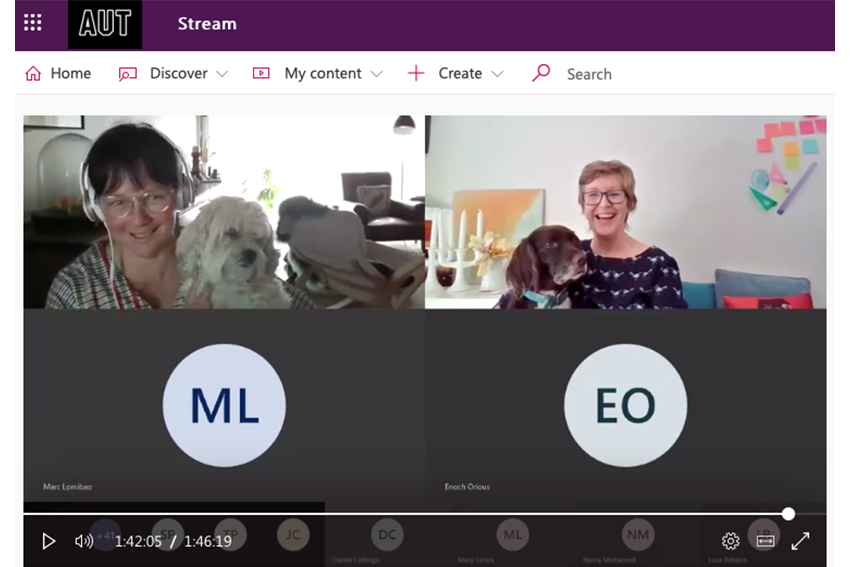Problem solving even under lock down

The move to online learning has meant a re-imagining for courses that usually rely on in-person collaboration and studio environments.
This is especially the case with the Bachelor of Creative Technologies programme which brings together the creative arts, design, digital media, computing, engineering and entrepreneurship in one project-based, creative and collaborative studio practice.
This semester, sixty first-year students will work on a solution for an unmet need highlighted by COVID-19 in an online, co-taught studio.
The co-teaching team has developed creative solutions to shifting a very hands-on learning-through-making course into a stimulating online environment where the students can meaningfully engage with course content under new circumstances.
Associate Head of Learning and Teaching for Huri te Ao, the school of Future Environments Donna Cleveland says the teaching team sees the pivot to online learning as a great opportunity to be open with students and connect with them in the shared experience of something new. “We won’t get it perfect first time and that is to be expected.
“We wanted to find ways to acknowledge the situation the students find themselves in now. Some are still in accommodation in Auckland and some have travelled home to be with families, but all have a sense of feeling displaced. The new studio challenge offers the students a space to reflect on what is currently happening in the world and to react, be innovative and design with what they have to hand.”
The themes were developed by canvasing the impact of social media challenges and reimagining them into a response to COVID-19.
Challenge Themes
- Healthcare equipment and workers. Addressing shortages of critical health care equipment: personal protective equipment, ventilators, etc. for medical staff and patients. Supporting and protecting front-line healthcare staff and their families
- Issues of mental and physical wellbeing during lockdown. Tools to address isolation, boredom, depression, anxiety. Tools that might help promote wellbeing such as fitness, routines, healthy eating and cooking, socialising, fun, learning
- Workforce issues such as coping with job loss or needing to adapt to a new way of working. Managing with reduced incomes, developing new digital skills
- Communication strategies that clearly inform and prevent confusing or incorrect information about COVID-19 and support minimising transmission of the virus in homes and communities
- Vulnerable groups such as the elderly, those with compromised immune systems, the homeless, the incarcerated, those with mental health issues, those living with disabilities, those in potentially unsafe/abusive situations
- Open call / Future visions and or versions of the world post COVID-19
To facilitate collaboration in the current circumstances, the teaching team has developed a virtual community share, or Barter Board. Students can trade skills and expertise they might need to get their idea off the ground with no money changing hands. The Barter Board is a place for facilitating collaboration between students; a place where students can post requests and offers of collaboration to our entire pool of students in an easy and dynamic way.
The bubble board is a place to ask for help with accessing resources from another bubble. If their idea involves someone within a demographic that is not inside of their bubble or if their idea requires analysing an item or a specific professional field that they do not have inside their bubble they can reach out to the bubble board.
Industry experts participate in weekly video conference sessions where they will discuss the themes and their impact on local and international communities and sectors. The final projects will be posted online for the public to see, and a panel of community and industry judges will select winning prototypes to receive mentorship to develop the students and refine their concept towards entry into AUT’s X-Challenge Accelerator.
“Donna and the team have done such an amazing job turning this challenging situation on its head and providing an opportunity to learn first-hand from this unprecedented historical moment,” says Shannon Thomas, Customer Manager at NZTE and Chair of the Advisory Board to the school. “It’s a privilege for those on the advisory board to see these future innovators at the beginning of their journey, and to support the programme by sharing our experience, networks, and advice. These students are the innovators that will create the changes we will see in the future.”
Dr Cleveland says she is excited about the students designing for the changing world they live in and the challenges they may face; using emerging creative technologies to address global challenges.
To contact staff about contributing to the COVID-19 student challenge or collaborating on other opportunities, please contact: <collaborate@aut.ac.nz>